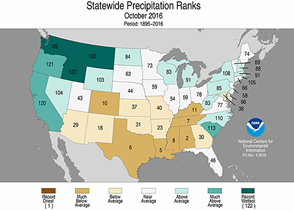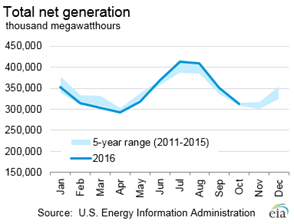
Electricity Monthly Update
Highlights: September 2020
- Wholesale natural gas prices set new 12-month lows in New England (Algonquin) and Louisiana (Henry Hub).
- Bonneville Power Administration set a new 12-month daily peak demand low on September 26.
- Net electricity generation in the United States decreased 7.3% in September 2020 compared to the previous year.
Key indicators
Average monthly electricity bills for residential customers in the United States declined in 2019
Source: U.S. Energy Information Administration, Form EIA-861, Annual Electric Power Industry Report.
Average monthly electric bills for residential customers in the United States were 1.8% lower in 2019 than in 2018. They declined by more than two dollars from $117.65 per month in 2018 to $115.49 per month in 2019. Since 2009, nominal average U.S. monthly electric bills have fluctuated within a narrow band from $105/month (2009) to $118/month (2018) with an average annual growth rate of 1%.
The U.S. Energy Information Administration (EIA) calculates average monthly bills by dividing total annual U.S. residential revenues by the number of customer accounts and by 12 (the number of months in the year). Generally, declines in the residential average monthly bill have been driven by reductions in average consumption per customer rather than decreases in average price, as was the case in 2019. Although the average U.S. residential price rose from 12.87 cents per kilowatthour (kWh) in 2018 to 13.01 cents/kWh in 2019, declines in average monthly consumption per customer from 914 kWh in 2018 to 887 kWh produced an overall reduction in average bills.
The reduction in average consumption per residential customers could be, in part, a result of cooler summer weather in 2019 relative to 2018. Heating degree days (HDDs) were up by 0.6% in 2019 compared with 2018, which would tend to increase consumption. However, cooling degree days (CDDs) were down by 5.3% in 2019, which pushed consumption down and more than offset the modest increase in HDDs. In addition, longer-term trends in energy efficiency have tended to push down average consumption over time. These trends in energy efficiency include increased use of behind-the-meter generation, high-efficiency appliances, LED (light-emitting diode) lights, and smart energy-saving devices (such as software programs for home automation systems). Since 2009, average monthly consumption per customer has fallen by 2.3% (908 kWh in 2009 versus 877 kWh in 2019).
Source: U.S. Energy Information Administration, Form EIA-861, Annual Electric Power Industry Report.
In 2019, at the state level, 12 states saw increases in their average monthly residential electricity bills. The highest percentage increase in 2019 was in Maine (4.7%). Although average consumption in Maine was down slightly, average bills increased even more because of upticks in residential rates as a result of increases in 2019 prices for standard offer supply service set by the Maine Public Utilities Commission. The second-highest increase in average bills was in Montana (2.4%). This increase was a result, in part, of slight increases in average consumption and interim rate increases approved by the Montana Public Service Commission in March 2019 (see docket 2018.02.012, final order 7604u, December 20, 2019). Six states experienced less than 2% increases in their average monthly residential electricity bills: Texas (1.9%), Wyoming (1.7%), Alaska (1.4%), Oregon (1.4%), Washington (1.2%), and Florida (1.2%). The remaining four states had less than a 1% increase in their average monthly residential electricity bills: Georgia (0.6%), Rhode Island (0.5%), South Carolina (0.4%), and Hawaii (0.05%).
In contrast, 38 states and the District of Columbia experienced a decrease in their average monthly residential electricity bills in 2019. The four states with the largest declines in average bills all had decreases in excess of 5%. Kansas had the largest percentage drop in its average monthly bill, down 9.2%, followed by New York (7.4%), Missouri (7.1%), and Ohio (5.8%). The remaining 34 states and the District of Columbia all had reductions that were less than 5%.
Source: U.S. Energy Information Administration, Form EIA-861, Annual Electric Power Industry Report.
| Hawaii | ||||
| Connecticut | ||||
| Alabama | ||||
| S.Carolina | ||||
| Mississippi | ||||
| Source: U.S. Energy Information Administration, Form EIA-861, Annual Electric Power Industry Report | ||||
The top five states with the highest average residential electricity bills in 2019 also ranked at the top in 2018. Hawaii, at $168.21, once again had has the highest state average monthly bill in 2019. Hawaii’s bills are at the top of this list mainly because electricity rates are almost three times the national average in Hawaii because of the state’s reliance on higher-cost, oil-fired generation that depends on marine imports of petroleum. Connecticut, with the second-highest bill ($150.71), had fairly modest average consumption levels (689 kWh), but its higher-than-average rates (21.87 cents/kWh) pushed it to the second position. The higher electricity rates in Connecticut are typical of the Northeast region, where the six New England states and New York are all in the top 10 for highest residential electricity rates. Rates tend to be higher in this region because of constraints on natural gas pipeline capacity during peak demand periods, the region’s significant distance from natural gas basins and storage locations, and a generally higher cost-of-living in this region. The remaining states in the top five (Alabama [$150.45], South Carolina [$144.73], and Mississippi [$135.87]) are similar in that they share geography, have slightly lower-than-average rates, and have high consumption levels because of significant summer cooling demand.
| Utah | ||||
| N.Mexico | ||||
| Colorado | ||||
| Illinois | ||||
| Idaho | ||||
| Source: U.S. Energy Information Administration, Form EIA-861, Annual Electric Power Industry Report | ||||
The five states with the lowest monthly average residential electricity bills in 2019 were Utah ($75.63), New Mexico ($80.04), Colorado ($83.07), Illinois ($92.37), and Idaho ($93.83). All (except Idaho) have both lower-than-average consumption levels and lower-than-average electricity rates. Idaho, meanwhile, has lower-than-average rates that more than compensate for its slightly higher-than-average consumption levels as a result of its significantly lower-cost hydroelectric generation capacity.
Principal Contributor:
- Name: Peter Wong
- Email: Peter.Wong@eia.gov






